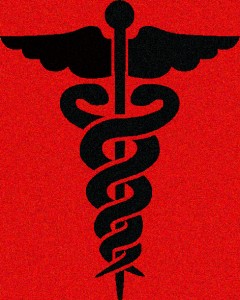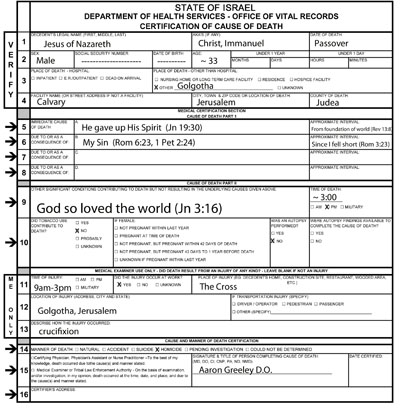Pulmonary Embolism—
Undoubtedly, Virchow’s triad was at work.
Could this account for the death of Jesus?
“He bowed his head and gave up his spirit.” —John 19:30
![]()
Make sure you fill in an accurate cause of death on the death certificate. Cardiopulmonary arrest is NOT a cause of death. It is a final pathphysiologic pathway initiated by some other abnormality.
These were the instructions of my attending internist during my medical training after the unfortunate passing away of a patient. Accurate medical information regarding the death of patients is important on many levels; medical statistics and public health, legal processes, and family closure to name a few. In fact, the CDC has published formal instructions on how to list an immediate cause of death and underlying conditions leading to the terminal event. There is even a box regarding the manner of death; i.e. natural, accidental, suicide, pending investigation, etc.
Have you ever wondered what caused Jesus Christ to finally pass away? What was the cause of his cardiopulmonary arrest? I recall a medical student gave a presentation about “Acute Pulmonary Thromboembolism” to the rest of our hospital team. In this presentation, she gave some background regarding this dangerous disease and reiterated some famous people who had died from a pulmonary embolus including possibly Jesus Christ!
Indeed, there  is little doubt that Jesus was at risk of pulmonary embolism (PE). The primary risk factor is deep venous thrombosis (DVT), which is said to be the result of three abnormalities; Virchow’s triad (hypercoagulability, intravascular stasis or turbulence, and endothelial injury).
is little doubt that Jesus was at risk of pulmonary embolism (PE). The primary risk factor is deep venous thrombosis (DVT), which is said to be the result of three abnormalities; Virchow’s triad (hypercoagulability, intravascular stasis or turbulence, and endothelial injury).
Jesus was most likely dehydrated (“I thirst.” Jn 19:28) after being arrested and enduring a long night of false trials. His dehydration was probably aggravated by the blood loss endured during the beatings, flogging, and the thorns piercing his very vascular scalp tissues. All of this would alter the normal consistency of his blood and contribute to hypercoagulability (the tendency of blood to coagulate more rapidly than normal).
With his arms and feet fixated to the cross, Jesus was unable to move for approximately six hours (Mark 15:25-37). The weight of his body over that time in his weakened state probably put severe stress on his shoulder joints, conceivably dislocating the joints further inhibiting his ability to move his extremities. Certainly, this would contribute to intravascular stasis such that it would increase the risk of DVT. In fact, a long car ride, a plane trip, or even lying sick in the hospital are usually enough to cause DVT. Preventative maneuvers are recommended by merely occasionally standing up to walk or strecing the legs and alternately relaxing and constricting the muscles in the legs to keep the blood moving.
Jesus did not have that simple luxury on the cross.Having been flogged by the Roman soldiers, the flesh on our Lord’s back was most likely severely lacerated. Pieces of metal, bone and rock in the whipcords sliced the skin open and likely penetrated the deep fascia in some areas so that the paraspinal muscles were exposed. The marks would extend from the shoulders to the legs. Arterial bleeding from the muscles layers was common. Furthermore the stretching of the arms and legs and the piercing of the arms and feet would account for the endothelial injury. When injured, the endothelium (inner lining of blood vessels) releases a cascade of chemical signals that increases the risk of intravascular coagulation.
Undoubtedly, Virchow’s triad was at work in the case of Jesus on the cross. Could this account for the death of Jesus? Could he have died because of deep venous thrombosis resulting in pulmonary embolism? Well, there are certainly other explanations of cardiopulmonary arrest that are just as probable during crucifixion.
[clearcol]
| Crucifixion as trauma |
When the Roman soldier pieced Jesus side after he was already dead, John records how blood and water poured out (Jn 19:34). Maybe, Jesus suffered severe pulmonary edema (fluid build up within the lung tissue) and pleural effusion (fluid build up within the chest cavity compressing the lungs) such that he was ultimately asphyxiated because he could not exchange oxygen appropriately. Perhaps, the spear pierced all the way to the chest releasing the fluid.
Or perhaps, the spear pierced his heart indicating Jesus died from cardiac tamponade; a condition in which fluid builds up in the pericardium (a thin sac around the heart) to the point where the chambers of the heart are compressed and cannot pump enough volume of blood forward to the rest of the body. Victims of such may suffer severe chest pain and a suffocating sensation.
Or maybe he died because of hypovolemic shock. Severe blood loss and dehydration would be a deadly combination in which the volume of intravascular blood is so low that the heart races and the blood vessels constrict to try to increase pressure in order to perfuse the other vital organs. Eventually, the heart cannot even perfuse itself and ultimately fails because of severe stress.
Crucifixion was invented by the Romans to be a long and painful process such that everyone could witness the suffering of the victims. This was an effective display of capital punishment designed to be a deterrent. Unlike, a firing squad putting a bullet into the head or a noose snapping the cervical spine and immediately severing the spinal cord, or a drug quietly putting a criminal to sleep and stopping the heart, crucifixion was a long slow process.
In fact, when it was taking too long for the Jews, they asked the soldiers to break the legs of the three individuals hanging on Golgotha that day (Jn 19:31-33). What is strange is that Jesus was already dead. The two criminals on either side of Jesus were still alive and their legs were broken to hasten the process. Apparently this was an effort to limit the criminals from lifting their bodies up with their legs in order to allow some expansion of the chest so that breathing could continue. Their arms and chests were so stretched that the diaphragm could not expand the ribs in order to exchange air and most individuals eventually died of suffocation. Not so with Jesus. He died prematurely as compared to the typical crucifixion. Even Pilate was surprised to hear that Jesus had already died (Mark 15:43-45).
Although conceivable, pulmonary embolism nor any other pathophysiology describes the death of our Lord. The gospels indicate otherwise. Matthew and John are clear as to how Jesus ultimately died.
And Jesus cried out again with a loud voice and yielded up his spirit. —Matthew 27:50
When Jesus had received the sour wine, he said, “It is finished,” and he bowed his head and gave up his spirit. —John 19:30
He gave up his spirit!? What does that mean? What pathophysiology can describe this? What would I write down as the cause of death on Jesus’ death certificate? “He gave up his spirit” would not satisfy my attending physicians, nor would it be admissible as a cause of death on a legal document such as a death certificate.
It may appear that I am interpreting “he gave up his spirit” too literally. Perhaps, this is just a descriptive way of saying he died. After all, he did stop breathing and his heart did cease contracting. So in a sense he did suffer cardiopulmonary arrest. Consider the following passage.
For this reason the Father loves me, because I lay down my life that I may take it up again. No one takes it from me, but I lay it down of my own accord. I have authority to lay it down, and I have authority to take it up again. This charge I have received from my Father. —John 10:17-18
This passage clarifies that it was not some faulty physiologic process that resulted in the death of our Lord. Nor was it one final straw that broke the proverbial camel’s back. This was a deliberate sacrifice. Not an accident. Not a pulmonary embolism. Make no mistake, it was a physical death like so many who have gone on before us (Phil 2:6-8, Heb 2:9-15). I cannot explain it more than to say, “He gave up his spirit.”
It was on his time. In essence it was in his way. So why did he choose this way? He didn’t deserve the cross; I did. He didn’t deserve those accusations, the mocking, the flogging, or the crown of thorns; I did. He took my place. Nothing but love can explain this (Jn 3:16, Rom 5:8, 2 Cor 5:19-21, 1 Jn 4).
As to the manner of death, I shouldn’t hesitate in checking the box next to “homicide.” It was my fault. I am the one. I may not know the exact cause of death, but the underlying conditions leading to the terminal event are clear; it was my sin and God’s love.
[clearcol]
Dr. Aaron Greeley

